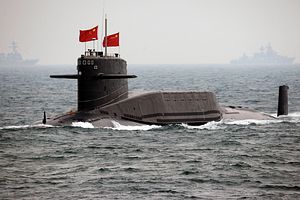The deployment of a Chinese nuclear submarine – presumably a Type 093 Shang-class – as part of the anti-piracy patrol of two ships and a supply vessel operating off the Gulf of Aden has set alarm bells ringing loudly in the Indian Navy. The implications of such a strategically significant move are simply enormous, as analysts try to decipher the real reason behind deploying such a platform in the region.
Submarines are not appropriate platforms for dealing with pirates or with piracy. The Somali pirates are known to use small craft known as skiffs individually or as part of swarm tactics to attack ships, returning to larger mother ships nearby. This gives them large operating ranges. Such highly manoeuvrable crafts can hardly be chased by relatively slow moving submarines or torpedoed from underwater, making submarines quite superfluous to anti-piracy operations. Apart from this, in a region where the incidence of piracy has declined to negligible levels, such that other navies are scaling back their presence, China is actually increasing its patrol strength.
China has been conducting independent counter-piracy deployments, mainly in the Gulf of Aden area, since 2008 as part of its Military Operations Other than War (MOOTW) and ostensibly for the common good. Since such patrols require coordination, the Chinese have been cooperating closely with the Indian, Japanese and South Korean navies, although they operate independently.
However, the deployment of the nuclear submarine from December 13, 2014 to February 14, 2015 with the PLA(N) flotilla – the 18th convoy from its South Sea Fleet – was unique and raises questions about China’s agenda. The Indian Navy has told the government that the Chinese may have been conducting hydrological studies in India’s western seaboard, as the Chinese task force was also joined by a research vessel capable of bathymetric studies: mapping the depth of the ocean floors. But the Navy also conceded that it did not spot the Chinese boats in Indian territorial waters.
Hence the rationale for the deployment of the submarine was open to interpretation and analysis.
First, it is well known that the Chinese initiative to deploy ships under the benign guise of anti-piracy patrols was a master stroke aimed at operating for extended periods in distant seas, and more importantly in India’s strategic backyard. Simultaneously, China was able to cooperate with adversarial navies such as Japan and India, enabling it to evaluate these navies (and vice versa).
Second, the deployment sent a strategic message, especially to the Indian security establishment, who have endlessly debated the strategic implications of the Chinese naval foray into the IOR. Clearly, the PLA(N) has the capability to project and sustain its blue water reach, operating thousands of miles from its base for an impressive seven months.
Third, Chinese nuclear submarines like the earlier Xia class were constrained in their ability to operate for even short periods beyond nearby waters. The new Shang and Jin classes are far superior technologically, as this deployment has demonstrated. Consequently, China has reaffirmed its prowess in creating high-tech platforms, along with its ability to project power and demonstrate “blue water” capability in distant oceans.
Fourth, frequent operation in the Indian Ocean will enable China to get a feel for the hydrological conditions in the region, facilitating additional underwater deployments.
Finally, while other navies in the region are looking to reduce their presence in anti-piracy patrols because of the financial burden and the sharp fall in the number of piracy attacks in the region, China has not only maintained its strength but increased it at times. The most likely rationale for this is giving its ships, submarines and crew a “sustained feel” for the area, perhaps in anticipation of frequent deployments in the near future. Hence, it is not idle speculation to suggest that both the Bay of Bengal and the Arabian Sea may become frequent hunting grounds for Chinese submarines, which could lie waiting at choke points or off Indian harbours to operate against the Indian Naval fleet in a crisis.
Clearly, India has a new maritime neighbour in China, which has the capacity to operate near Indian shores and in the Indian Ocean. India neglects this potential threat at its own peril.
Dr. P K Ghosh is a Senior Fellow at the Observer Research Foundation. He is the former lead co-chair of the CSCAP international Study Group on Naval Enhancement in Asia Pacific. He can be reached at [email protected]

































